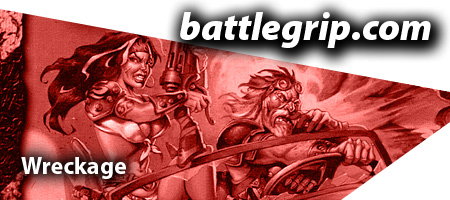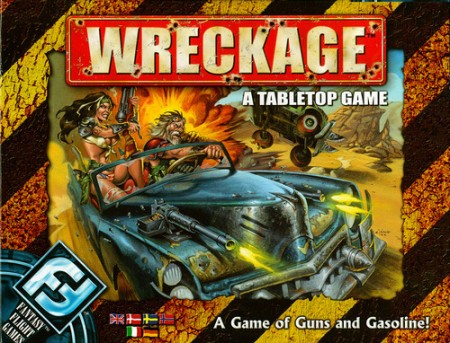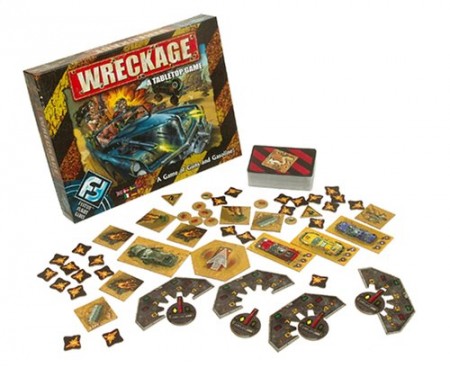Review – Wreckage

NOTE: This review was originally written in early 2004. I have been wasting time on the web for many, many years.
Wreckage*, a tabletop game from Fantasy Flight Games, is subtitled “A Game of Guns and Gasoline!†This attractive, very professionally-design and presented game pits two to four players against each other in automotive mayhem and destruction. My brief review, for those of you anxious to move on to other things, is that this game rocks. If you’ve any interest in games about cars with guns you need this game in your collection.
Now, for those of you who have no need to rush off immediately, let’s take a much closer look at Wreckage.
Priced at $19.95, Wreckage* comes in a 10†x 8†x 1.5†sturdy box. The box artwork and graphics are superb and fill me with such a powerful case of envy that I find myself wishing I could have been responsible for the art direction and graphic design of the game. The cover – pictures above – is by Jesper Ejsing and instantly evokes the attitude of the game. At a glance you can tell that this game is all about driving fast and shooting things and that, sometimes, things blow up. The photo of the game components that’s displayed on the back of the box is clear and an excellent teaser for what you’re about to find inside.

Upon opening the box, the first things that you’ll encounter are a small catalog and the rules. The catalog is what you would expect and does its job of making me want to rush out and buy more games from Fantasy Flight Games. The rulebook, at first glance, may intimidate you. A 7†x 10†booklet, 32-pages in length, my first fear was that this was an overly complicated game and, I suspect, that would be your fear as well. Luckily for all of us the rules comprise only 5 of the 32-pages . . . the remaining pages are devoted to the rules in 5 other languages. Let’s set aside the rules for now and see what else is in the box.
After the rules we find two large sheets of die-cut counters and several smaller sheets of die-cut counters. My first thought upon hefting one of these sheets was, “I wish Dork Tower had included such nice components.†For $20 I expected nice counters but these are amazing. Very heavy stock. Beautiful artwork. Everything I could ever want from die-cut counters. While I’m not going to count the number of individual counters – and the rules don’t give a count – I will say that I feel there are more than enough counters for the price I paid. The counters represent everything from a speedometer and car for each player to obstacles, hit tokens, gas cans, and a range ruler to the spinout counter.
The final component found in the game is the card deck. The cards, as with the other components, are of the highest quality and full-color. The cards are divided into six decks during play. These are:
- Equipment cards: 18 cards of which each player will get three during the game. Weapons, armor, turbo boosts and other gadgets all work together to customize your car.
- Steering cards: Four different decks, one for each player. Each deck includes five identical cards and two special cards that are unique to that deck. The cards are used during play to accelerate, decelerate, turn left or right, repeat a maneuver, or to execute a special maneuver. The specials, which include cards like barrage – fire all of your weapons – and crush – perfect when ramming another car – help to give each car a unique flavor.
- Damage cards: 38 cards that are drawn to determine damage caused from combat and collisions. Each card shows from 0 to 3 hits of damage and, at times, a special damage. The three special damages are spinout, critical damage, and shuffle.
Once you’ve got all of your counters punched and decks separated, you can dive right into the game. I recommend starting play with two players so that you can get a handle on how things work. A first player is chosen randomly (the game doesn’t offer any suggestions on how to do this but I’m sure we’ll figure it out) and that player then selects a car. Each car includes three attributes, which are:
- Acceleration: From 1 to 4. This is how much the car can speed up or slow down when the appropriate card is played.
- Handling: From 0 to 3. Handling is used for dodging attacks.
- Structure: From 3 to 10. Once a car has accumulated as many hit tokens as its structure it is destroyed and the player is out of the game.
Once the first player has selected his car the others do likewise, in clockwise order around the table.
Once cars are selected the last player to choose a car selects one equipment card and then passes the deck counter-clockwise. This is repeated until all of the players have three equipment cards each. Selecting at least one weapon is highly recommended.
Now once the cars, gas cans, and obstacles are placed on the table (a diagram shows the proper placement) the game starts. The damage deck is shuffled and placed to the side any every player sets his speed on his speedometer (see below).
The Speedometer
This game component consists of two parts: The actual speedometer portion that tracks speeds between 0 and 4 and the needle that slots into the speedometer and is moved to show the car’s current speed. The speedometer, in play, is a cool tool and allows everyone to see your current speed at a glance. The needle is two-sided and also keeps track of whether you’re traveling forward or in reverse.

All of the players select two steering cards form their own deck and place them face down on the table. The player moving the fastest – or with the highest Handling in the event of a tie – goes first. On your turn you flip one card and perform the action it calls for. The range ruler covers turns and distance and a move can be completed in a matter of seconds. If you move over a gas can you keep that gas can counter. If you move into an obstacle or other car a collision takes place (see below).
Collisions
If your car counter touches an obstacle or vehicle you instantly stop moving and reduce your speed to 0. Then draw a number of damage cards equal to the speed you were moving and apply those hits to your Structure. If you hit another vehicle draw another set of cards equal to the speed you were moving and apply those hits to that vehicle. A car with a number of hits equal to its Structure is removed from play and the player removed from the game.
Once you move you may attack another player if he’s within range and line-of-sight. The range ruler is used for both of these things and after a try or two you begin to get a feel for when you can or cannot attack. If you can attack declare the weapon you’re using and draw a number of damage cards equal to the number printed on the weapon. Total the hits on the damage cards drawn and reduce that total by the target’s Handling. Any remaining hits are applied to the target. If the total number of hits sustained by the target equals the target’s Structure the target is destroyed and the player removed from the game.
It’s now the next player’s turn. The second Steering card will be revealed after once around the table and then two Steering cards will be placed face down by all of the players and the process repeated again.
The first player to collect three gas cans – or the last player with a moving car – wins the game.
Conclusion
As you can see, Wreckage* is a fast-playing, fairly simple tabletop game. While there are some optional rules included in the game – special ways to use each of the different obstacles – they don’t really complicate the game.
Beautiful art and graphics, combined with high-quality components and fast-play, make Wreckage an excellent game for kids, the family, or just a group of friends looking for a diversion between television shows or while waiting to start a roleplaying session.
The simplicity of the game does slightly wound the game’s replay value. With only one starting setup presented and a set number of options available to each player a lot of games will start to feel the same. And while there are more equipment cards than can be used in a single game most are similar to others so the variety isn’t as good as it could be. But, for $20 I have to say that Wreckage* is an excellent buy and a fun, fast game.
1 thought on “Review – Wreckage”
Comments are closed.